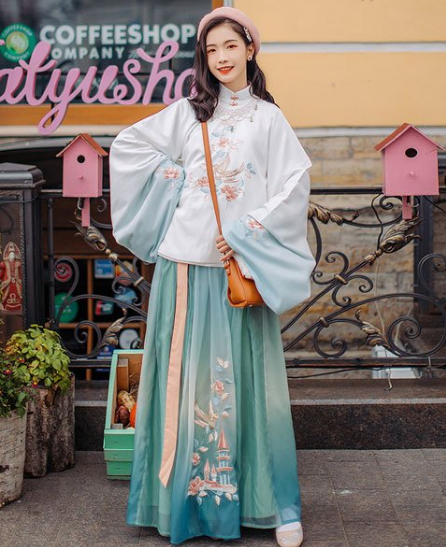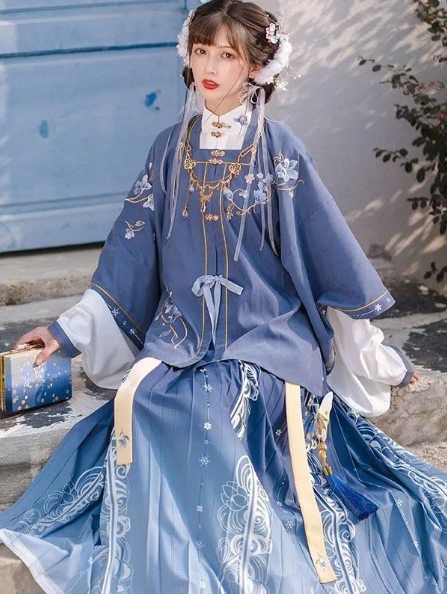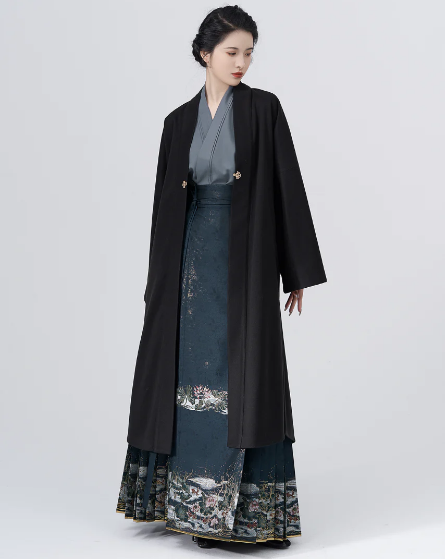Hanfu today represents a revival of traditional Chinese clothing, blending ancient styles with modern fashion influences.
Historical Overview of Hanfu
Origins and Evolution of Hanfu
The journey of Hanfu begins in the depths of ancient China, tracing back to the earliest dynasties. As a distinctive form of traditional Chinese attire, Hanfu emerged during the reign of the legendary Yellow Emperor. This period marks the initial shaping of Hanfu, characterized by its cross-collared robes and wide sleeves. Artifacts and historical texts, such as those found in the Shang Dynasty tombs, offer glimpses into Hanfu’s early design elements. These pieces highlight the use of silk, a material synonymous with Chinese culture, and elaborate embroidery showcasing ancient motifs.
Over centuries, Hanfu evolved with each dynasty adding unique touches. The Zhou Dynasty, for instance, introduced the concept of ‘Yi’ and ‘Shang’, setting protocols for upper and lower garment styles. This era also saw the standardization of colors and designs based on social hierarchy. During the Han Dynasty, which gives Hanfu its name, the attire became a symbol of Han Chinese identity. This period solidified key features like the ‘Ru’ (confucian robe) and ‘Shenyi’ (deep robe), epitomizing elegance and simplicity.

Hanfu in Ancient Dynastic Eras
Each subsequent dynasty contributed distinct elements to Hanfu, reflecting the era’s ethos and aesthetics. The Tang Dynasty, renowned for its cultural openness and prosperity, introduced vibrant colors and more relaxed fits, mirroring the period’s cosmopolitan nature. Women’s Hanfu, in particular, became more diverse, with styles like the ‘Beizi’ – a long tunic worn over a skirt. The Song Dynasty followed, emphasizing modesty and refinement in Hanfu designs, as seen in the ‘Songku’ – a skirt with pleated panels.
The Ming Dynasty marked a significant era for Hanfu, with the introduction of the ‘Aoqun’, a style combining a fitted jacket and a pleated skirt. This period also witnessed the height of Hanfu craftsmanship, with intricate patterns and luxurious fabrics. It’s essential to note the variations in Hanfu during these times, influenced by factors like climate, geography, and social status. For instance, Hanfu in northern regions often featured thicker materials and darker colors compared to the lighter and brighter versions in the south.
In these dynastic eras, Hanfu wasn’t just clothing; it represented a way of life, embedding Confucian ideals and showcasing the wearer’s social status. Despite its evolution, the core philosophy of harmony and balance in Hanfu’s design has remained a constant thread throughout history. These ancient styles continue to influence modern Hanfu, serving as a bridge connecting past and present in Chinese culture.
Revival of Hanfu in the 21st Century
Modern Hanfu Movement
The 21st century marks a pivotal point in Hanfu’s history, witnessing its remarkable resurgence. This revival primarily stems from a growing interest in traditional Chinese culture among the youth. Driven by a desire to reconnect with their heritage, young Chinese have spearheaded the modern Hanfu movement. This movement goes beyond fashion, embodying a deeper quest for cultural identity and pride. It actively promotes the wearing of Hanfu in daily life and during traditional festivals, making a statement of cultural reclamation and preservation.
Key events like the Hanfu street parade in 2003 in Zhengzhou played a significant role in popularizing the movement. These events showcase the beauty and diversity of Hanfu, drawing public attention and media coverage. The movement also gains momentum through online forums and communities, where enthusiasts share knowledge, organize events, and discuss styling tips. Moreover, the establishment of the Hanfu Society in various universities has created a structured platform for promoting and preserving this cultural attire.
Influence of Social Media and Pop Culture
Social media and pop culture significantly amplify the impact of the Hanfu movement. Platforms like Weibo, Douyin (TikTok), and Bilibili serve as vital spaces for Hanfu enthusiasts to showcase their attire, share experiences, and foster a sense of community. Influencers and celebrities donning Hanfu contribute to its rising popularity, often setting trends and influencing design elements.
The world of entertainment, particularly historical dramas and films, plays a crucial role in this revival. These productions often feature exquisite Hanfu costumes, attracting viewers and inspiring them to explore traditional attire. For instance, popular TV shows like “The Story of Yanxi Palace” and “Nirvana in Fire” have significantly influenced Hanfu trends, with viewers seeking replicas of the costumes worn by characters.
Moreover, the fusion of Hanfu with modern fashion elements has led to its increased acceptance among the wider public. Designers are reimagining Hanfu with contemporary twists, making it more adaptable to modern lifestyles while retaining its traditional essence. This blend of old and new has made Hanfu more accessible and appealing, especially to the younger generation, who find in it a unique way to express their cultural roots in a modern context.
Design and Aesthetics of Modern Hanfu
Traditional Elements in Contemporary Designs
Modern Hanfu design brilliantly intertwines traditional elements with contemporary fashion sensibilities. Designers respect ancient principles, often incorporating classic Hanfu components like ‘Ru’, ‘Ao’, and ‘Shenyi’ into modern pieces. These traditional styles, known for their cross-collar robes and flowing sleeves, serve as the foundation of modern Hanfu. Designers meticulously select fabrics, favoring silk and brocade to maintain authenticity, while introducing modern fabrics for comfort and practicality. Embroidery, a hallmark of traditional Hanfu, still adorns modern designs, featuring motifs like dragons, phoenixes, and floral patterns that have deep cultural significance.
In color selection, modern Hanfu often mirrors historical preferences for symbolism. Red, symbolizing good fortune and joy, and yellow, once reserved for royalty, are popular choices. However, contemporary designs also embrace a broader palette, incorporating pastels and muted tones to appeal to modern aesthetics. The balance between adhering to traditional color symbolism and embracing contemporary trends illustrates the evolving nature of Hanfu.
Innovation and Fusion in Modern Hanfu
Innovation in modern Hanfu design reflects a fusion of historical elegance with current trends. Designers are not afraid to experiment, blending Hanfu styles with elements from Western fashion. This results in unique creations like Hanfu-style dresses and coats, which offer a fresh take on traditional attire. These fusion pieces often feature adjusted waistlines, hemlines, and necklines, aligning with modern comfort and style preferences.
Technological advancements in fabric production and garment construction also contribute to this innovation. Designers use new materials and techniques to enhance the durability and wearability of Hanfu, making it suitable for everyday wear. For instance, wrinkle-resistant and washable fabrics are now common, a significant shift from the delicate silks of ancient times.
This innovative approach extends to accessories as well. Modern Hanfu ensembles often include contemporary jewelry, bags, and shoes, creating a harmonious blend of old and new. This fusion not only makes Hanfu more relevant to today’s fashion but also broadens its appeal beyond traditionalists, attracting a diverse range of enthusiasts.
Cultural Significance and Identity
Hanfu as a Symbol of Cultural Heritage
Hanfu stands as a profound symbol of Chinese cultural heritage, embodying thousands of years of history, art, and philosophy. Each fold and fabric in Hanfu tells a story, linking the present to a rich historical tapestry. The revival of Hanfu is not just a fashion trend but a deeper reconnection with the cultural roots of ancient China. It serves as a living reminder of China’s dynastic history, traditional values, and artistic achievements.
Hanfu’s styles and motifs often depict legendary stories, myths, and classical literature, thus preserving and propagating these tales to new generations. The attire is also integral to traditional festivals and ceremonies, where it adds layers of meaning and authenticity. For instance, during the Lunar New Year or the Dragon Boat Festival, wearing Hanfu becomes a way to honor ancestors and celebrate Chinese heritage.

Role of Hanfu in Promoting Chinese Identity
In the context of globalization, Hanfu plays a critical role in promoting and maintaining a unique Chinese identity. As China’s influence expands globally, Hanfu emerges as a cultural ambassador, showcasing the richness of Chinese traditions to the world. It offers a distinct contrast to Western fashion, highlighting the diversity and complexity of global cultural expressions.
Within China, the Hanfu movement fosters a sense of unity and national pride among the Chinese people. It encourages the younger generation to delve into their history, learn about traditional customs, and carry forward their cultural legacy. For many, wearing Hanfu becomes an expression of pride in their Chinese identity, reinforcing a sense of belonging and community.
Moreover, Hanfu’s popularity among the diaspora serves as a cultural bridge, connecting people of Chinese descent worldwide. It allows them to celebrate their heritage and share it with others, regardless of where they live. This aspect of Hanfu transcends mere aesthetics, positioning the attire as a powerful tool for cultural diplomacy and mutual understanding.
Hanfu in Fashion and Retail
Trends and Popularity in Fashion Industry
Hanfu has made a significant impact on the fashion industry, emerging as a trend that combines cultural heritage with contemporary style. Designers are increasingly incorporating Hanfu elements into their collections, attracting attention on both national and international runways. This blending of traditional and modern aesthetics resonates with a broad audience, appealing to those who appreciate cultural depth in their fashion choices.
The popularity of Hanfu has soared, particularly among the younger demographic, who view it as a fashionable and meaningful way to express their identity. This interest has led to the emergence of dedicated Hanfu brands, each offering a unique interpretation of this traditional attire. The demand for Hanfu has also influenced mainstream fashion brands, prompting them to explore this niche market.
Hanfu in Online and Offline Retail Markets
In the retail sector, Hanfu has found a strong presence both online and offline. E-commerce platforms like Taobao and JD.com feature a wide range of Hanfu options, catering to different tastes and budgets. These platforms make Hanfu accessible to a wider audience, enabling people from various regions to explore and purchase these garments with ease.
Offline, specialized Hanfu stores are popping up in major cities across China, offering customers the opportunity to experience and try on Hanfu first-hand. These stores often provide a full range of services, including customization, fitting, and styling advice, enhancing the shopping experience. Additionally, cultural festivals and Hanfu events often feature pop-up shops and vendor stalls, further boosting the visibility and availability of Hanfu in the retail space.
The expansion of Hanfu into various retail channels reflects its growing popularity and the potential for further growth in the fashion industry. As more people embrace Hanfu, its presence in both online and offline markets is likely to continue flourishing, making a significant impact on the global fashion landscape.

Global Influence and Perception
International Awareness and Adoption
Hanfu is gaining international awareness, transcending China’s borders and capturing global interest. This growing fascination is evident in various cultural exhibitions, international fashion shows, and cultural exchange programs where Hanfu is prominently featured. Non-Chinese individuals and communities are increasingly embracing Hanfu, drawn to its elegance and cultural richness. This adoption extends beyond mere fashion, as people worldwide engage with the philosophical and historical aspects of Hanfu, appreciating it as a gateway to understanding Chinese culture.
Social media platforms play a crucial role in this spread, with numerous Hanfu enthusiasts from different countries sharing their experiences and styles online. This global community fosters a deeper understanding and appreciation of Hanfu, helping to debunk stereotypes and promote a more nuanced view of Chinese culture.
Hanfu in Cross-Cultural Exchanges and Diplomacy
Hanfu’s role in cross-cultural exchanges and diplomacy is becoming increasingly significant. As a cultural symbol, it serves as a bridge between China and the world, facilitating mutual understanding and respect. Hanfu is often a centerpiece in cultural festivals, exhibitions, and diplomatic events, where it represents Chinese culture’s beauty and diversity.
In international relations, cultural diplomacy using elements like Hanfu can enhance goodwill and cooperation between nations. For instance, during state visits or international summits, the presentation of Hanfu as gifts or its inclusion in cultural performances can leave lasting impressions, fostering friendly relations.
Moreover, Hanfu’s integration into global fashion and cultural discourse contributes to a more diverse and inclusive international cultural landscape. This exchange not only enriches global cultural heritage but also highlights the importance of preserving and respecting diverse cultural expressions.